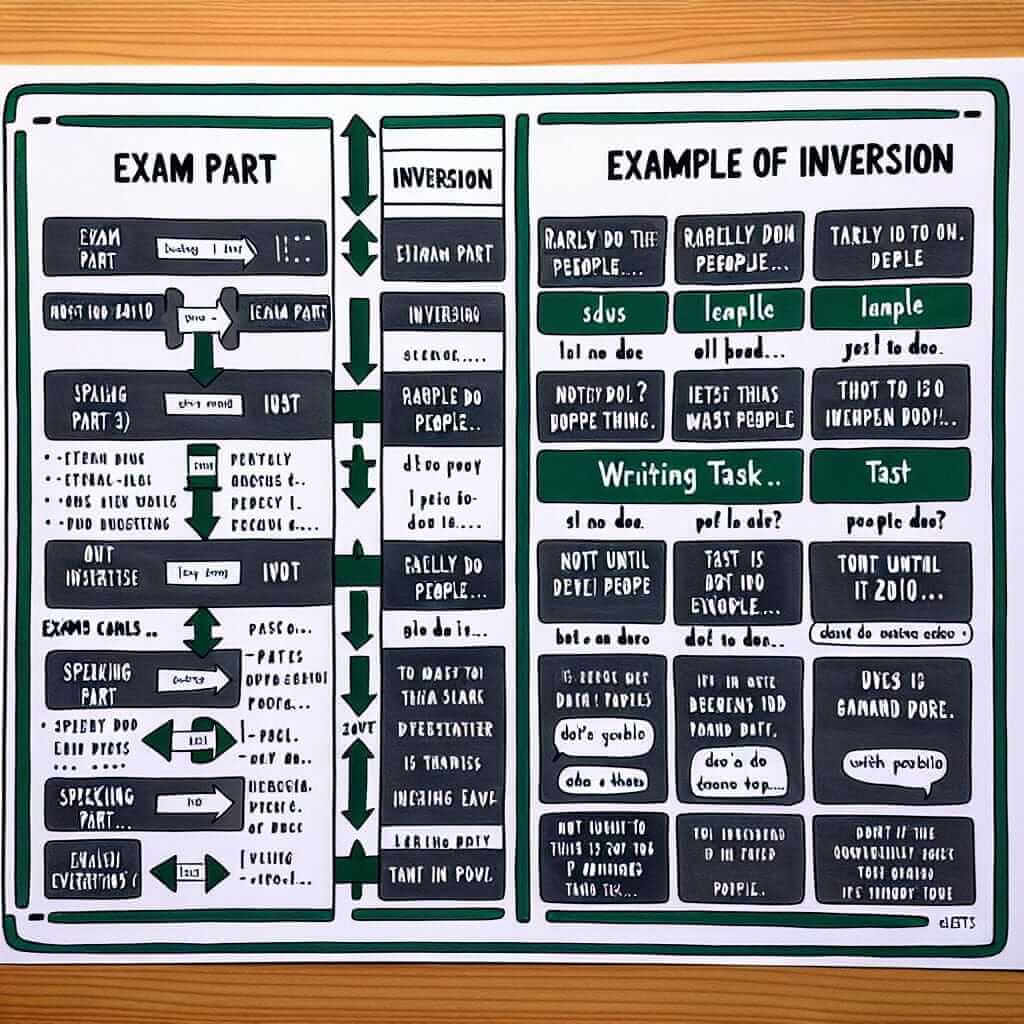Have you ever encountered sentences like “Not until the very end did we realize the truth” and wondered about their grammatical structure? This type of sentence, characterized by an inverted word order, is a powerful tool to elevate your IELTS writing and speaking, showcasing a sophisticated command of English grammar. This article delves into the intricacies of inversion, providing you with the knowledge and skills to utilize this structure effectively in your IELTS exam.
Let’s examine some examples of inversion in different sections of the IELTS:
Speaking:
- Part 2 (Describe a time you had to wait for something): ” … and not until the airplane’s wheels touched the ground did I finally breathe a sigh of relief.”
- Part 3 (Discussing patience): “Rarely do people associate instant gratification with patience these days…”
Writing:
- Task 1 (Describing a graph showing an increase in online sales): “Not until 2010 did online sales begin to surpass those of traditional retail stores.”
- Task 2 (Essay on the importance of environmental protection): “Only by acknowledging the urgency of the situation can we begin to implement effective solutions…”
In each example, the inversion of the subject and auxiliary verb creates emphasis and a more formal tone, demonstrating a higher level of grammatical accuracy.
Understanding Inversion in English Grammar
Inversion, simply put, is reversing the typical subject-verb order in a sentence. While the standard English sentence structure follows Subject-Verb-Object (e.g., “She ate the apple”), inversion often places the auxiliary verb or the main verb (if it’s “to be”) before the subject (e.g., “Rarely does she eat apples before dinner.”).
Why is Inversion Relevant for IELTS?
Utilizing inversion correctly demonstrates a strong command of complex grammatical structures, which is a key factor in achieving a band score of 7 or higher. It allows you to:
- Enhance vocabulary and grammar range: Inversion often goes hand-in-hand with less common vocabulary (like “rarely,” “seldom,” “not only,” etc.), further demonstrating your lexical resource.
- Improve sentence fluency and cohesion: Inversion can be used to vary sentence structure and create a more natural flow in your writing and speaking.
- Create emphasis and dramatic effect: By altering the typical word order, you can draw attention to specific points and make your language more engaging.
Mastering Inversion: Rules and Applications
Inversion with Negative Adverbs and Adverbial Phrases
Rule: When a negative adverb or an adverbial phrase with negative meaning is placed at the beginning of a sentence, we invert the subject and the auxiliary verb.
Examples:
- Never have I seen such a beautiful sunset. (Negative adverb)
- Under no circumstances should you open this door. (Adverbial phrase)
- Not only did she win the race, but she also broke the world record. (Negative adverb)
Analysis: In these examples, the negative adverbs (“never,” “under no circumstances,” “not only”) trigger the inversion. The auxiliary verb (“have,” “should,” “did”) comes before the subject (“I,” “you,” “she”).
IELTS Application:
- Writing Task 1: “Not until the 20th century did electricity become widely available.” (Describing a historical trend)
- Speaking Part 3: “Rarely do we consider the long-term consequences of our actions.” (Discussing societal issues)
Inversion with “Only” and “No Sooner”
Rule: Inversion is used after the adverbs “only” and “no sooner” when they are placed at the beginning of a sentence for emphasis.
Examples:
- Only after years of practice did he master the art of calligraphy.
- No sooner had I sat down than the phone rang.
Analysis: “Only” and “no sooner” are adverbs of time used to emphasize the immediacy or exclusivity of an event. Notice the use of the past perfect tense after “no sooner.”
IELTS Application:
- Writing Task 2: “Only by working together can we overcome this challenge.” (Presenting solutions in a problem-solution essay)
- Speaking Part 2: “No sooner had I arrived at the station than the train pulled away.” (Recounting a personal experience)
Inversion with Conditionals
Rule: In formal English, we can use inversion in conditional sentences to replace “if.” This is more common in writing.
Examples:
- Were I to have more time, I would travel the world. (Instead of: If I were to have more time…)
- Had she known about the danger, she would have never gone there. (Instead of: If she had known about the danger…)
Analysis: Notice how the auxiliary verb (“were,” “had”) comes before the subject (“I,” “she”) in these examples.
IELTS Application:
- Writing Task 2: “Were the government to invest more in renewable energy, we could reduce our dependence on fossil fuels.” (Expressing a hypothetical situation)

Common Errors to Avoid
- Overusing inversion: Remember, inversion is used for emphasis and formality. Don’t overuse it, as it can sound unnatural and forced.
- Incorrect auxiliary verb placement: Ensure the auxiliary verb is correctly placed before the subject.
- Using inversion in informal contexts: Inversion is typically used in formal writing and speaking. Be mindful of the context.
Conclusion
Mastering inversion not only showcases your grammatical prowess but also allows you to communicate ideas with greater emphasis and sophistication. By understanding the rules and practicing its application, you can confidently incorporate this advanced grammatical structure into your IELTS writing and speaking, boosting your overall band score. Remember, consistent practice and exposure to a variety of examples will help solidify your understanding and improve your fluency.